-
[pdf]
[supp]
[bibtex]@InProceedings{Wang_2025_CVPR, author = {Wang, Xuan and Gao, Xitong and Liao, Dongping and Qin, Tianrui and Lu, Yu-liang and Xu, Cheng-zhong}, title = {A3: Few-shot Prompt Learning of Unlearnable Examples with Cross-Modal Adversarial Feature Alignment}, booktitle = {Proceedings of the IEEE/CVF Conference on Computer Vision and Pattern Recognition (CVPR)}, month = {June}, year = {2025}, pages = {9507-9516} }
A3: Few-shot Prompt Learning of Unlearnable Examples with Cross-Modal Adversarial Feature Alignment
Abstract
In the age of pervasive machine learning applications, protecting digital content from unauthorized use has become a pressing concern. Unlearnable examples (UEs)--data modified with imperceptible perturbations to inhibit model training while preserving human usability--have emerged as a promising approach. However, existing UE methods assume unauthorized trainers have extensive exposure to UEs or that models are trained from scratch, which may not hold in practical scenarios, This paper investigates the effectiveness of UEs under the few-shot learning paradigm, pitching it against prompt learning (PL) models that leverage pretrained vision-language models (VLMs), like CLIP, capable of generalizing to new classes with minimal data. To address this, we introduce an adaptive UE framework to generate unlearnable examples that specifically target the PL process. In addition, we propose a novel UE countermeasure, A3, with cross-modal adversarial feature alignment, specifically designed to circumvent UEs under few-shot PL. Experimental evaluations on 7 datasets show that A3 outperforms existing PL methods, achieving up to 33% higher performance in learning from UEs. For example, in the scenario involving l_infinity-bounded EM perturbations, A3 has an average harmonic mean accuracy across 7 datasets of 82.43%, compared to CoCoOp's baseline of 65.47%. Our findings highlight the limitations of existing UEs against PL and lay the foundation for future data protection mechanisms.
Related Material





